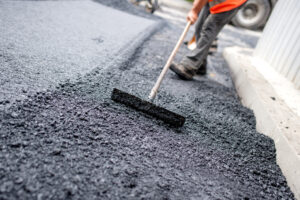Asphalt is everywhere in our daily lives – on roads, driveways, and parking lots – but have you ever stopped to think about what makes it such a reliable material? Whether you’re a homeowner looking to install a new driveway or a property manager tasked with maintaining a parking lot, understanding the basics of asphalt is key. In this guide, we’ll walk you through everything you need to know about asphalt, from its composition and benefits to practical maintenance tips. You’ll learn how to protect your investment and keep your asphalt surfaces looking great and functioning smoothly for years to come.
What is Asphalt?
Asphalt is a durable and versatile material known for its flexibility, smooth surface, and ability to withstand heavy pressure. It is made from a mixture of aggregates, such as sand, gravel, and crushed stone, combined with a bituminous binder (bitumen). This binding material is created from crude oil and gives asphalt its characteristic sticky, black appearance. Asphalt’s sturdy composition and versatility make it the go-to choice for many paving projects.
Asphalt Composition and Types
As we mentioned earlier, asphalt is composed of two primary components: aggregates and bitumen. The aggregates make up about 95% of the material, while bitumen, which binds the aggregates together, makes up the remaining 5%. The mixture’s proportions and the type of aggregate used can vary depending on the application.
There are three common types of asphalt:
- Hot Mix Asphalt (HMA): Heated and mixed at high temperatures, this type works best for large-scale projects like highways and major roads. It’s known for its durability and strength.
- Warm Mix Asphalt (WMA): Produced at lower temperatures than HMA, WMA produces fewer emissions and is more environmentally friendly. It is useful for projects in extreme weather conditions and can improve working conditions by reducing exposure to fumes.
- Cold Mix Asphalt: Made without heat, cold mix is a more affordable option and can be purchased in smaller quantities than HMA. It’s normally used for small, temporary repairs like patching potholes when the outside temperature is too cold. It’s not as durable as HMA or WMA, but it is easy to apply.
To decide which type of asphalt is right for your project, consider its advantages, cost, and usual applications.
Benefits of Using Asphalt
Asphalt offers a range of benefits, making it a popular choice for both residential and commercial paving projects:
- Durability: Asphalt is highly resistant to wear and tear, handling heavy traffic and extreme weather conditions with ease. Asphalt surfaces also provide long-term value, lasting for 15 to 30 years if properly maintained.
- Smooth and Quiet Surface: Asphalt creates a smooth, even surface that minimizes road noise and provides comfort for drivers. This makes it a great option for residential areas and places where noise reduction is important. The surface also offers better traction.
- Cost-Effective: Asphalt is more affordable than concrete, both in terms of installation and long-term maintenance. Its quick installation reduces labor costs and easy repairs help keep the overall expenses low.
- Environmentally Friendly: Asphalt is 100% recyclable, which makes it an environmentally-responsible choice. Since asphalt can be reused in new paving projects, the demand for new materials is reduced and its environmental impact is minimized.
- Quick Installation: Unlike concrete, which requires time to cure, asphalt can be driven on almost immediately after installation. This quick turnaround makes it ideal for time-sensitive projects by minimizing disruptions to traffic and daily activities.
In general, asphalt is a reliable and budget-friendly option for homeowners and property managers alike.
Frequently Asked Questions About Asphalt
Asphalt is a common material, but many people still have questions about its properties, maintenance, and installation. Here are some of the most common questions and our responses:
How Long Does Asphalt Last?
The lifespan of asphalt depends on several factors, including the quality of the materials used, the amount of traffic it handles, and how well it is maintained. On average, well-maintained asphalt surfaces last between 15 and 30 years. Regular maintenance, such as crack sealing and sealcoating, can help to extend the life of the pavement.
Can Asphalt Be Recycled?
Yes, asphalt is one of the most recycled materials in the world. Asphalt recycling is a common practice in the paving industry, involving milling old asphalt and processing it to be reused in new asphalt mixtures. This environmentally friendly process encourages reusing old materials instead of creating new raw materials.
Is Asphalt Safe for the Environment?
Asphalt is considered environmentally friendly because it is recyclable and can be reused multiple times. Additionally, modern asphalt production techniques produce fewer emissions than in the past, further reducing its effect on the environment.
How Often Should Asphalt Be Sealcoated?
Sealcoating is an important maintenance practice that helps protect asphalt from the elements, such as UV rays and moisture. Most experts recommend sealcoating asphalt every 2-3 years, depending on the level of wear and tear the surface experiences.
Hopefully, these common questions cleared up any confusion or concerns you had about asphalt. If you have any other questions, feel free to contact us!
Common Maintenance Practices for Asphalt
To keep your asphalt surfaces looking great and functioning properly, regular maintenance is essential. Asphalt is durable, but like any material, it requires some care to last as long as possible. Here are some of the most important maintenance techniques you should take to extend the lifespan of your asphalt.
Crack Sealing
Over time, cracks can form in asphalt surfaces due to weather changes, heavy traffic, or wear and tear. Sealing these cracks promptly prevents moisture from digging under the surface and causing further damage. Crack sealing involves filling the cracks with a special sealant to prevent water infiltration and protect the underlying layers of asphalt.
Sealcoating
Sealcoating is a protective layer applied to the surface of asphalt to shield it from UV rays, rain, snow, and other environmental factors. It helps prevent oxidation and cracking, which can lead to more significant damage. As we said before, sealcoating should be applied every 2-3 years.
Pothole Repair
Potholes are a common issue with asphalt surfaces, especially in areas with freezing and thawing cycles. Potholes occur when water seeps into the asphalt, causing it to weaken and break apart. Repairing potholes can be pricey, but it should always be done swiftly to prevent further damage.
Resurfacing
As asphalt ages, it’ll likely show signs of wear. This is usually noticed by fading color, surface cracks, or rough texture. Asphalt resurfacing involves applying a new layer of asphalt over the existing surface to restore its appearance and functionality. Resurfacing can extend the life of your asphalt by several years and improve its overall performance.
By following these steps, you can keep your asphalt surface healthy and attractive for the years to come.
Superior Asphalt is Here to Help Maintain Your Asphalt
Proper asphalt maintenance can protect your investment and ensure safety for those who use it. Whether you’re dealing with cracks, potholes, or simply want to extend the life of your pavement, staying on top of maintenance is key. At Superior Asphalt, we specialize in providing high-quality asphalt maintenance services for homeowners and property managers. From asphalt repairs to sealcoating and resurfacing, we’re here to keep your pavement in top shape. Have questions about asphalt or need an exact pricing quote? Contact us today!



